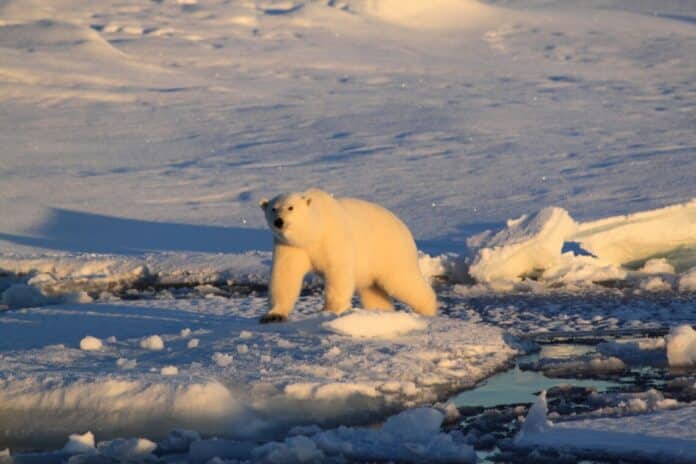Researchers from the University of Washington and Polar Bears International in Bozeman, Montana, have found a relationship between greenhouse gas emissions and the survival of polar bear populations.
A polar bear was the first species listed under the Endangered Species Act in 2008 due to climate change. Researchers predicted that up to two-thirds of the world’s polar bears could disappear by the middle of the century because of warming.
A warming Arctic is reducing polar bears’ access to sea ice, which they use as a hunting platform. The bears must fast during the warm months when there is no ice. While adult bears will die in the worst-case situation, they will lose their capacity to raise cubs before they die successfully.
Cecilia M. Bitz said, “I hope the U.S. government fulfills its legal obligation to protect polar bears by limiting greenhouse gas emissions from human activity; I hope investments are made into fossil fuel alternatives that exist today and to discover new technologies that avoid greenhouse gas emissions.”
According to the Endangered Species Act, any government-authorized project, including oil and gas leases, cannot endanger any listed species. However, the Bernhardt Opinion, a document issued by the United States Department of the Interior in 2008, required specific proof of how a proposed project’s greenhouse gas emissions would affect a species’ survival before the ESA could be fully implemented for species threatened by climate change.
Lead author Steven Amstrup, chief scientist emeritus at Polar Bears International and adjunct professor at the University of Wyoming, said, “We’ve known for decades that continued warming and sea ice loss ultimately can only result in reduced distribution and abundance of polar bears, Until now, we could not distinguish impacts of greenhouse gases emitted by particular activities from the impacts of historical cumulative emissions. This paper reveals a direct link between anthropogenic greenhouse gas emissions and cub survival rates.”
The new study connects polar bear fasting limitations and ice-free days to greenhouse gas emissions. It discovers that hundreds of power plants in the United States. It finds that the hundreds of power plants in the U.S. will emit more than 60 gigatons of greenhouse gas emissions over their 30-year lifespans, which would reduce polar bear cub survival in the southern Beaufort Sea population by about 4%.
He said, “Overcoming the challenge of the Bernhardt Opinion is absolutely in the realm of climate research. When the memo was written in 2008, we could not say how human-generated greenhouse gas emissions equated to a decline in polar bear populations. But within a few years, we could directly relate the quantity of emissions to climate warming and later to Arctic sea ice loss. Our study shows that sea ice and polar bear survival can be directly related to our greenhouse gas emissions.”
The new study has implications beyond polar bears and sea ice. The same analysis method may be used for other species and habitats directly linked to global warming, such as coral reefs, the endangered Key deer, or beach-nesting animals endangered by rising sea levels.
He said, “Polar bears are beautiful creatures, and I hope they survive global warming. However, the health and well-being of humans, especially the most vulnerable, is paramount. All of us have experienced heat extremes in the last few years. The harm is inescapable.”
The new study provides insight into the declining trends in specific polar bear subpopulations, including western Hudson Bay. It helps evaluate the impact of future actions.
Researcher said, “Everything governments and industries can do to reduce greenhouse gas emissions matters and will help avoid the worst consequences. I’m excited to see the innovative proposals for the Inflation Reduction Act. I hope they stimulate the healthier future that polar bears and all of us need.”
Polar Bears International and the National Science Foundation funded the study.
Journal Reference:
- Steven C. Amstrup,Cecilia M. Bitz, et al.Unlock the Endangered Species Act to address GHG emissions. Science. DOI: 10.1126/science.adh2280
